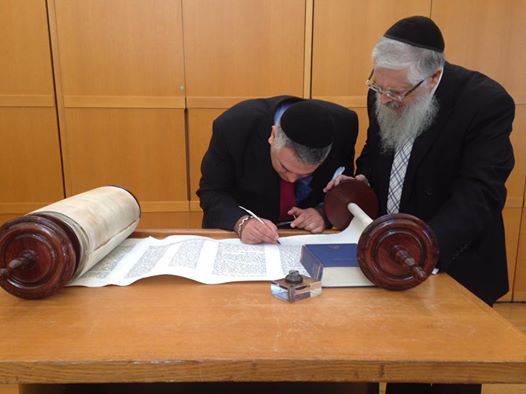"You stand this day, all of you, before the Eternal One your God...to pass into the covenant..." (Deuteronomy 29:9-11)
It may be possible to receive the Torah every day - but I mean that metaphysically.
Tangibly, physically to receive the Torah, as a new scroll, in the way the Lobel family of New York City made possible for Harvard Hillel this past week - and actually participating, as a few of us were privileged to do, in completing the writing of the text, with our own hands - is a rare experience.
There is a tradition that says: God and Torah and Israel are One - not just that each of these realities, God, and Torah, and Israel, are unique, but that together these actualities constitute a Unity.
And if that is so, then this Oneness is not whole without all of its components.
Without the Torah, it is not quite possible to proclaim, in our particular way, "God is One" (Deuteronomy 6:4); much less to say, "How goodly are your tents, O Jacob, your dwelling places, O Israel" (Numbers 24:5); or to ask rhetorically, as our scriptures do, "Has God ever ventured to come and take one nation from the midst of another nation, by trials, by signs, and by wonders, and by war, and by a mighty hand, and by an outstretched arm, and by great terrors, according to all that the Eternal One your God did for you in Egypt before your eyes?" (Deuteronomy 4:34)
The whole point of the Torah is that we and the Divine constitute a story together. Take either party away - or, of course, the telling itself - and the story ceases to exist.
And that truth - our being bound up in a story together with God - as a unity, a fabric, a tissue of law and lore, and love - is not merely something that once was, a tale of bygone days. We go on writing fresh chapters of the story every new day.
I say 'there is a tradition' that God and Torah and Israel are one - and there is, we even sing it (♫ Yisrael, Ve'Oraita, VeKudesha B'rich Hu, Chad Hu ♩) - but, fascinatingly, it is quite unclear where that formulation originates.
You can check me on this. One can find the statement easily in the works of latter-day commentators, often followed by the Hebrew word "kayadua" - "as is known." It is especially frequent in Hasidic literature, particularly in the writing of Rav Tzadok Ha-Kohen of Lublin (1823-1900), and the Me'Or Enayim (Rabbi Menachem Nachum Twersky of Chernobyl, 1730-1787). Sometimes an annotation will point toward the Zohar, and thus at least as far back as the Jewish mystical tradition of 13th century Castile. But the page of the Zohar cited (vol. III p. 73a) does not quite say the words that we are looking for. What it does say: "There are three gradations, linked one to the other - the Blessed Holy One, the Torah, and Israel - and each one of these, gradation upon gradation, is both concealed and revealed." Only by breaking the sentence prematurely can one construct "God, Torah, Israel - and all are one." But then, the point of mysticism is that all is One - so the play is hardly out of bounds.
We like to know where things come from - in rabbinic tradition, it is almost an obsession. But in this instance, I think it is poignant, and maybe even perfect, that we know that we know, and yet do not know quite how we know: that we and God and Torah together are One.
Whatever the way in which you think of Torah coming to us, consider for a moment the act of putting ink on parchment to form the words of a scroll that will be lifted up in the midst of a congregation to choruses of "This is the Torah that Moses placed before Israel, according to God's word." One might as well be writing in black fire upon white fire, as ancient interpretation imagines the original. Creating sacred text is perhaps the height of human spiritual audacity.
And yet the scribal tradition is perhaps the epitome of modesty in Judaism. (This was personified so beautifully and gently this past week by Rabbi Shimon Miara, our scribe here in Cambridge.) As a scribe, transmitting Torah from one generation to the next, one does not assert oneself, one does not sign one's work, or add personal flourishes, much less words, and one does not (heaven forefend) subtract. One copies diligently, and fades into the background, into the letters and into the ages.
But, insofar as there is some volition and expression of one's soul involved, as participant in the unity - which letter did I choose, to help finish the scroll?
The final yod of "le'eyney" in the last verse of the Torah - "....before the eyes of all Israel," the letter that makes those eyes plural. I truly believe that without them all, the Torah is not complete.
Here's to a year of many different and wonderful eyes looking into Torah - here at Harvard, and far and wide - for inspiration, to see what they will discover, and to contemplate how they will continue the story!
"You shall be a beautiful crown in the hand of the the Eternal One, And a royal diadem in the palm of your God." (Isaiah 62:3)


